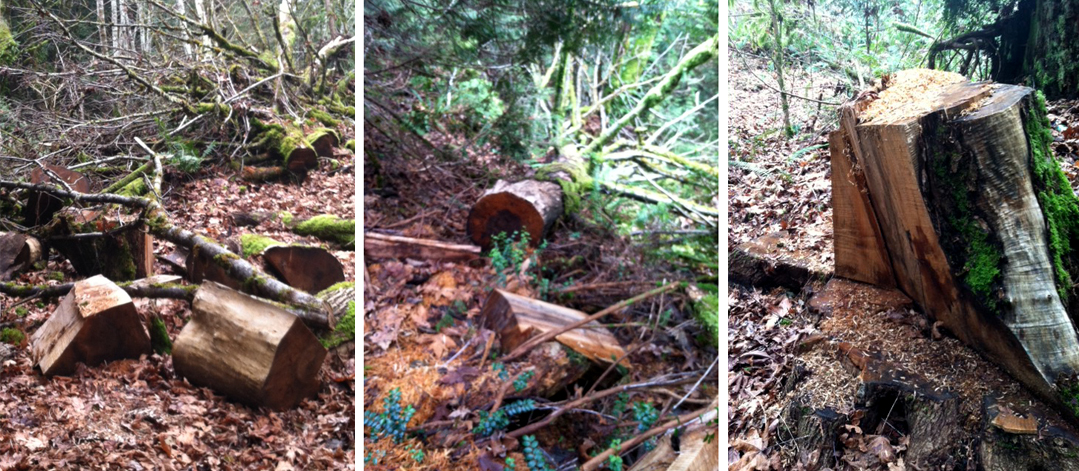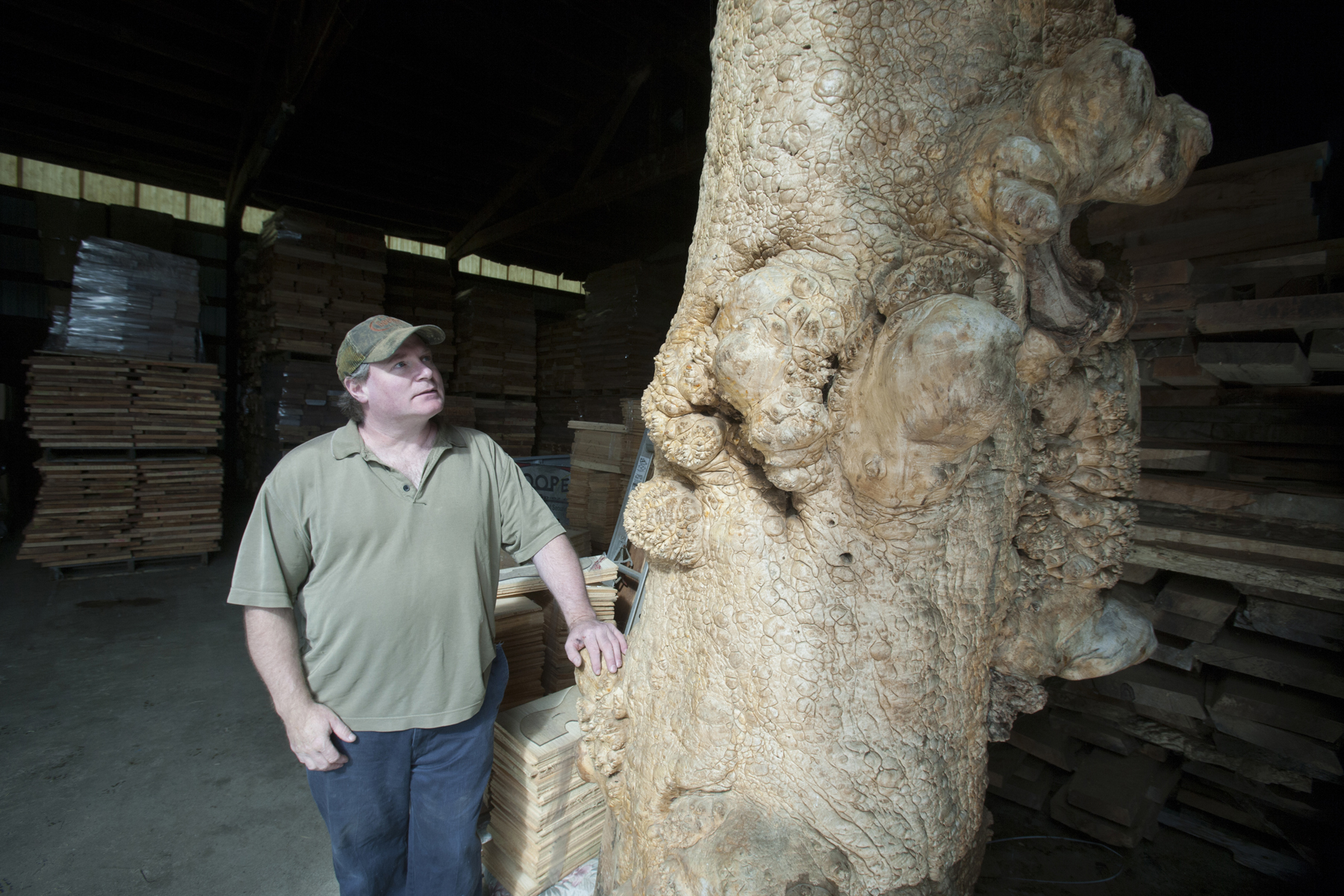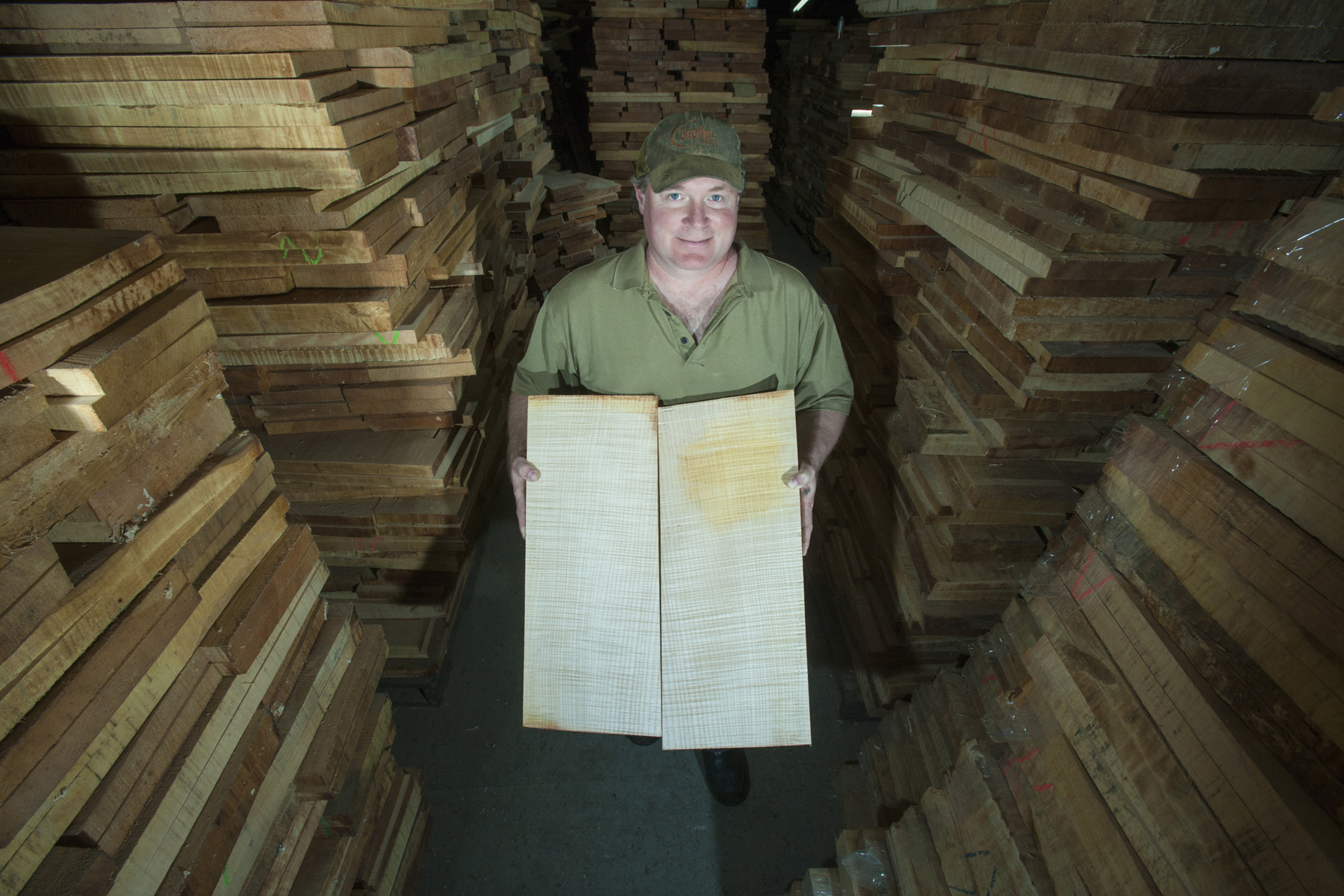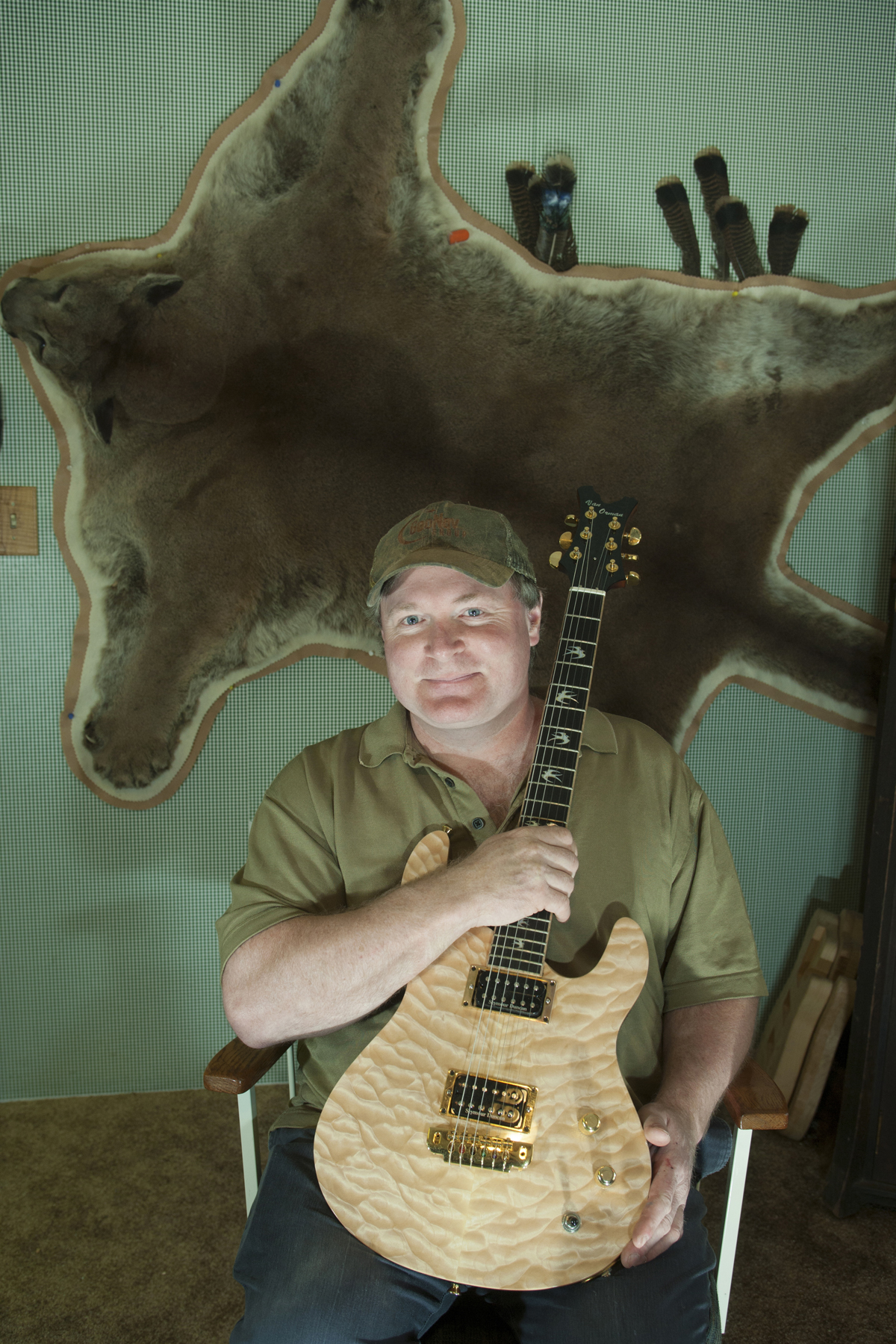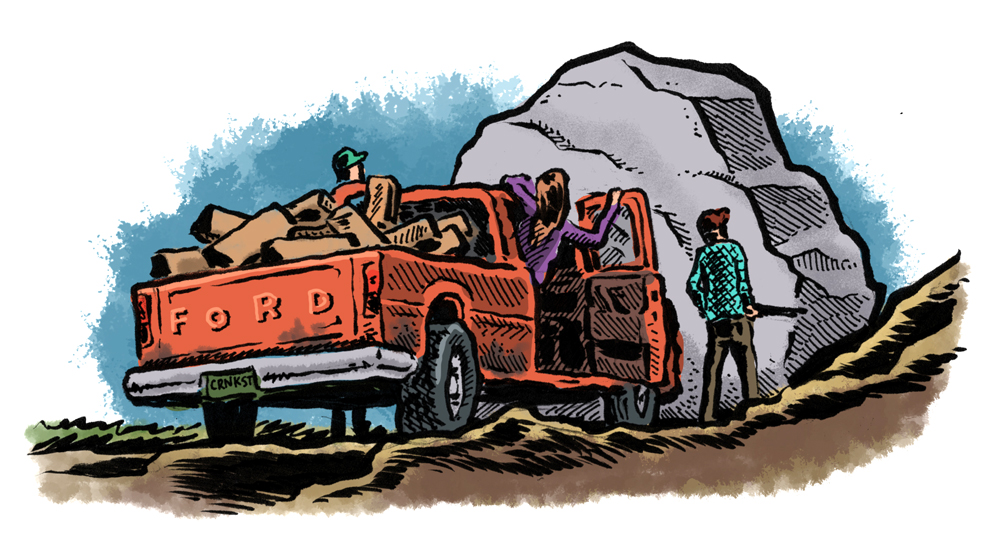Perched above the northeast shore of Harstine Island in south Puget Sound lies a rugged, wild quilt of state forest, 112 acres of pristine Mason County land. It is lush with bounty: moss, salal, mushrooms, cascara, fir boughs, curled ferns, bear grass, salmonberry, blackberry, and huckleberry. Almost six feet of rain have drenched the low eastern valleys of the Olympic Mountains since December, and the vegetation stands eyeball-high. Here the mushy terrain is so impenetrable that lurking timber thieves, many feeding a serious methamphetamine addiction, hack their way through with machetes as they seek the most lucrative prize of all—the big-leaf maple.
On an early March day, Washington State Parks ranger Mischa Cowles, her rig bucking and rolling along a deeply rutted timber road, is en route to the scene of the crime. The morning’s pouring rain has ceased and the afternoon has turned blue and bright, though you wouldn’t know it. Low-hanging branches of cedar and fir slap wickedly at the windshield, and groves of towering trees are pressed so tight together that a dark shadowy green falls across these woods. As the pickup truck creeps onward at five miles per hour, the scenery is a riot of rotting log carcasses, gnarly limbs draped with moss, hemlock, and waterlogged mud wallows. One almost aches for the sight of a clearing.
“You see those truck tracks? It’s a fresh trail that they’ve made. It might have been an old timber road. Over here, that was their landing spot,” confides Cowles. “There’s a stump there. There’s another one, see it? It’s a mess. See what they do? It’s so sad, you know, hundred-year-old maples down on the ground.”
Cowles has been working the state-parks beat for 16 years, nearly half that time maintaining trails and tending to the marine campers who flock during warmer months to Harstine’s Jarrell Cove State Park. She’s an effervescent 42-year-old with short-cropped brown hair and glasses. Strong and built low to the ground, Cowles moves like a cat on this spongy terrain.
“What I’ve heard is that things can be pretty scary,” she says, scurrying down a muddy incline. “You don’t want to mess with them. They’re armed.”
Moving on foot now, her exhausted pickup parked on a patch of dirt no bigger than a dorm room, Cowles recalls how she made the disturbing discovery on a rainswept mid-January morn. Investigating an abandoned trailer, she noticed a freshly punched road. It hadn’t been there before. She followed the road and came upon a deep ravine. There at the bottom were 21 formerly full-grown maples, cut to the quick. Most likely it occurred in the dead of night, police say, with a wheezing hydraulic chainsaw, the kind preferred by poachers that dampen a saw’s roar. Some of the majestic maples that were destroyed had lain down roots before World War I and stood close to 100 feet tall.
“There were 10 trees here, over there a few more, and over and down below—can you see?—that’s where they got the rest of them,” Cowles says in a cemetery-like whisper. Surveying the ugly swath of carnage, a maze of sawdust and stumps, discarded Coke cans and faded cigarette cartons, the ranger observes, “You’d have to be high on meth to get down this far and to be able to do what they did.”
After a long pause, Cowles goes on. “You see what they do? Look—see the check marks, where they cut off a section of the bark? They’re looking for stress marks, which will tell whether there’s figured wood. They know what they’re doing. They’re looking to see if there’s music wood to be gotten.”
As much as 90 percent of each felled tree is left behind, left to rot. Maple rustlers are not exactly known for their environmental consciousness. Their reckless extraction wreaks havoc on the forests and costs taxpayers untold millions in reparation.
The Harstine Island thieves knew exactly what they were looking for: precious “figured wood” hiding beneath the rugged bark, embedded deep within the heart of the maple. It’s as rare as it is beautiful, a magnificent, three-dimensional wood-grain pattern that comes in two forms. There’s quilt maple, a lustrous, bubbly pattern, and flame—also known as tiger stripe or fiddleback—which displays an endless series of parallel lines when finely sanded and finished.
In the hands of a craftsman, decorative figured maple wood, harder than mahogany and with a brighter sound than rosewood, is used for the backs, sides, and necks of most string instruments—acoustic and electric guitars, violins, cellos, etc.—so well does it carry sound waves. This is the material that the guitar-making giants— Gibson, Martin, Taylor, and Fender—use for high-end guitars costing $8,000 to $20,000 or more. Santana’s own guitar, in fact, was crafted from Northwest fiddleback.
Of all forest products, the big money is in maple. “Anywhere you have maple, you’re going to have theft,” states Jason Bodine, a police officer with the state Department of Natural Resources. “And Mason County, along with Grays Harbor and Pacific [counties], are pretty much ground zero for the figured wood.”
A 3-by-10-by-24-inch block, or billet, of quilted maple can fetch a poacher $100; the flame goes for about $40, according to forest-product experts. A single big-leaf maple, if well-endowed, can yield $5,000 from a buyer, who may or may not inquire—or even give a rat’s ass—whether the seller harvested the wood with the necessary permit.
Typically, a timber theft is treated as a gross misdemeanor, which carries a $1,000 fine and up to a year in jail, but convictions are rare, says Bodine.
The Jarrell Cove timber heist “was a big one,” marvels Robert Ingram, chief of enforcement for Washington State Parks. “I can’t recall in the last 10 years or more anyone doing this many.”
Or, as James Freed, a natural-resources professor at Washington State University, put it, “It is so rare to find this many trees on one location with that much figured wood. For these crooks, it was like hitting the jackpot.”
Shelton, Mason County’s seat, is a place straight out of a Richard Russo novel: gritty, disheveled, but still as resilient as a wildflower. Unlike at nearby Forks, there is little effort or enthusiasm to reinvent itself. Don’t expect vampire tours here anytime soon. The town’s economy was long ago built around logging, when timber was king of the hill. But for more than 30 years, the industry has been in steady decline. Call it Empire Falls. In the late 1980s, residents slapped bumper stickers on their pickups that read “Save a Logger, Kill a Spotted Owl.” Those were the days when unemployment hit almost 30 percent and boarded-up stores, foreclosed homes, and drunken, angry displaced loggers were a common sight in Mason County and throughout the timber towns of the Olympic Peninsula.
The economy has rebounded some, but the timber industry continues to falter. In 2001, there were 93 sawmills in Washington, a good number of them in Mason County. Today there are 23. The number of shingle mills, some 37 a dozen years ago, has shriveled to seven, according to the state Department of Natural Resources. Now the two largest employers are the Little Creek Casino Resort and the prison, the Washington Corrections Center. Unemployment still lingers at 10.2 percent.
The sign at Shelton’s city limits reads “Christmas Tree Capital.” It’s an accurate boast, for the county bursts with fir and cedar boughs and salal, a leafy shrub favored by florists worldwide, who use it for bouquet fillers and holiday wreaths. The plant, shipped all over the world, has become a $350 million industry.
The market for music wood, too, is robust. Huge figured-wood buyers and suppliers, like Don Van Orman in nearby Elma, are rushing to fill the U.S. market’s demand for acoustic and electric guitars, which grew, respectively, 28 and 12 percent from 2010 through 2012, according to the National Music Merchants Association.
“What you have out here now is a gold-rush mentality,” says Freed. Referring to the maple-tree thieves, Freed postulates, “They’re society’s dropouts. They work without a net. The same guy who is taking down these trees is poaching salmon and killing elk out of season. But, I’ll tell you what—yeah, they got issues with meth and so on, but they are the greatest capitalists in the world.”
Van Orman is less charitable: “I call them crankster gangsters.”
Last month, on a blustery gray morning, a couple of desperados are sitting against a brick wall in an alleyway near the Pine Cone Restaurant in downtown Shelton, sipping beer from cans encased in paper sacks.
One of the men, a 50-something guy who calls himself Bo, hocks up a brown tendril of chewing tobacco and laughs like a happy lunatic when the wad plunks down in a pool of muddy water. Clad in a tattered gray peacoat, a small angel tattoo on his neck, Bo says he used to be a brush picker, and made a tidy sum of money gathering bear grass and selling it to local florists. Did some mushroom picking too. Says the work, though, was hard, and that he developed a bad back and ended up on partial disability.
Asked what he knows about the demand for maple, Bo brightens and replies, “Oh, yeah, you mean the music wood. I know some guys who do it. Oh, man, they work like dogs for that damned money, and then they smoke it up and do it all again. It’s a weird deal. I asked one of them why he can’t find any easier way to steal. And he just says to me, he says, ‘It’s real easy to do this shit and not get caught. Real easy.’ ”
That’s where Mason County Sheriff Deputy Jason Sisson comes in. He’s lived his whole life in and around Shelton, and knows all about these back-country bandits who may trade as much as $1 billion worth of illegal domestic wood each year in the U.S., according to an investigation by the Associated Press. Married with two young kids, the 37-year-old Sisson is the lone ranger out here, the only cop in all of Mason County whose job it is to hunt down maple moochers and other timber crooks—the ones making off with cedar, used for shingles or shakes; spruce, employed for ornamental woodworking; or Douglas fir for firewood. Green Diamond Resources, a substantial timber harvester who controls 200,000 acres in the county, hired Sisson three years ago and pays 80 percent of his salary to patrol its maple-rich forest lands.
“We’ve had a contract with the Mason County Sheriff’s Office for 10 years now to provide a police officer because of the increasing amount of theft on our forest land,” says Green Diamond spokeswoman Patti Case.
Deputy Jason Sisson’s a big man, built like a linebacker, and has a swagger to him. “I do like catching the bad guys,” he says with a wink. Seated in the conference room at the sheriff’s office on North Third Street, his back to a bulletin-board posting that reads “Navy Seals: 1, Bin Laden: 0,” he quickly warms to the subject of forest-product theft. “We got hundreds of brush pickers out here. The vast majority of them are totally legit. They’re out doing the mushrooms, the bear grass, and salal, and they got their permits.”
As to the timber wolves, “I can tell you a lot of them are meth-heads, no doubt about it. They’re pretty young, 20s and 30s. I don’t how many are out here. Maybe 100 of them are operating in these parts, in and around the county. I don’t know. No one really does. I’ll be out on a site that they hit, and I’ll see energy [-drink] cans all over the place, candy wrappers. They’ll put anything in their bodies to keep ’em going. I mean, they’re out there with goggles and headlamps and chainsaws, felling 200-foot trees in the middle of the night!”
They are a cunning bunch, Sisson goes on—and bizarrely resourceful. “I’ve seen them use car hoods as sleds so they can haul the wood out. They’ll roll the stuff down to the beaches and make off with the [music] wood, all cut up in the right-sized chunks, and load it into boats. They’ll stand there and hook hoses to the saw muffler and stick it in a bucket of water to make it quieter. I’ve seen pickup trucks go into areas that you’d never think was possible to get into, some of the thickest, roughest, cobbiest brush you can imagine. I’ll find abandoned, stolen pickups—they like them small pickups—just beat to hell.”
Sisson says nearly every one of them is armed and dangerous. “And they are not easy to catch. They’re pretty damned sneaky. You come upon them and all they’ll do is run. So no, I’m not going to be down in that ravine with a chance of blowing out a knee if I chase after them. Hell, they all got guns, machetes, axes. They’re high on meth. I mean, these guys are paranoid, and you’re out there with them in the freaking middle of the night! No, I’ll just get the truck towed.”
Sisson recounts a sting he put together last July with some state Department of Fish and Wildlife officers. “We got a report that there was an operation being run at night. It was in north Mason County. We went out there and saw some trees down, maples. And we knew they’d be back.
“I can’t tell you how we knew they’d be back. I got ways to catch them, but there’s no way I could have that put in the newspaper,” Sisson continues, clearly enjoying his tale of catch-me-if-you-can. “So it was 12:30 a.m. We got them leaving the area. We rolled out a boulder onto the road, and when they stopped, we converged. There were two adult males and a teenage daughter, probably there for lookout. They had a freshly cut block of music wood, five really good ones ready to sell. They had meth on them and miscellaneous drug paraphernalia, and for some reason, they also had an air gun.”
An air gun? “Look, years ago, I stopped trying to think like these guys, because you can’t. There’s no logic to them. They fly by the seat of their pants.”
Just then, Sisson’s cell phone rings. “This is my guy, my informant,” he says, lowering his voice and cupping the receiver. “He wants a reward if he’ll talk about the maples at Harstine.” Sisson asks him, “So you got a good lead?”
“Oh. yeah, I got a lead all right,” the informant gushes. When Sisson doesn’t respond right away, the caller presses the point: “Look, if you scratch my back, I’ll scratch yours.”
Sisson smiles. “So you know who it is?”
“Oh, yeah, I know.”
“No, I don’t have a problem keeping this confidential,” he tells the snitch. “All right, look, I’ll get back to you. I don’t know what money might be available.”
Sisson hangs up and says, “I’ve dealt with this guy before, and I don’t 100 percent trust him. For all I know, he could be out stealing trees himself, and he wants me to keep off of him, or it could be he wants to get himself some firewood today, and so he knows if I catch him doing that, he’ll figure I won’t do anything because he knows I might need him in the maple case.
“But, anyway, we’ll see. I’ll call [parks ranger Mischa Cowles] and see about reward money, which he’s not going to get anyway without an arrest and conviction—which is really tough to do. Because if you don’t catch these guys red-handed, there’s not much you can do.” The pursuit of the Jarrell Cove maple thieves continues.
The crooks know their chances of getting caught range somewhere between slim and none, mainly because the sheer amount of acreage to cover is daunting. Some do get caught—like Floyd Stutesman, a recovering meth addict from Hoquiam who was nailed by federal agents for cedar theft in 2008. But he views his arrest as little more than bad luck. “If a guy wants to take a chance out there, cutting down trees illegally, it’s a pretty good bet no one’s gonna catch ’em,” says Stutesman, who is in the final months of a five-year probation.
There’s too much turf and not enough cops—and the time and effort required to investigate theft sites or track stolen wood back from the mill to the harvester is far more than law-enforcement agencies can spare. There are 22 million acres of forested land in Washington, about 40 percent of it owned by big timber companies and private individuals. The DNR controls 1.2 million acres of it—more than the size of Olympic National Park—and has just nine enforcement agents. Because of budget cuts, the state has closed a dozen state parks since 2000 and moved 66 of its 180 full-time rangers to seasonal jobs. Most of them have too much on their plate to chase down timber thieves in the dead of night. At the same time, there are thousands of miles of accessible forest roads in the Pacific Northwest, again making it extremely difficult for authorities to catch crooks in the act.
“Basically, we just don’t know the magnitude of the problem,” says Seth Wilkinson, a Special Assistant U.S. Attorney in Seattle. “Only a handful of them are caught and prosecuted each year. What we do know, though, is these are resources that cannot be replaced.” Wilkinson is handling the case of Reid Johnston, who in December was sentenced to a year in prison for cutting down 102 maple, cedar, and fir trees in the Olympic National Forest between May 2009 and January 2010. It was one of the largest timber-theft cases in Washington history. One of the Douglas firs, its trunk about seven feet in diameter, was believed to be more than 300 years old.
The son of well-to-do parents now deceased, Johnston has a history of drug problems, including meth, and remains behind bars at the federal detention center in SeaTac. He is currently awaiting a federal court decision on the value of the stolen resources to determine the amount of restitution he will have to make.
“You got to remember, this product, the figured wood from the maple, doesn’t have a bar code on it,” says Green Diamond Resources’ spokesperson Case.
Ironically, one of the thieves’ greatest tools is the permitting process used by legitimate harvesters. Officials agree the process is a farce. Fake permits abound. “The system relies totally on the honesty of the buyer,” says WSU professor Freed. “It is extremely difficult to know what wood has been stolen—plus, since the music wood is cut up into blocks, it’s very easy to conceal.”
To get a permit, all a person must do is fill out a “harvest application” at their county sheriff’s office. The $5 application asks for the name of the landowner on whose property the harvest will take place, its location, the expected time frame, and how much wood or other forest products will be taken.
“The problem is that they’ll get the permit and use it for what they said they would, but then they’ll use it in other areas to steal the maple,” opines Deputy Sisson. “So maybe you’ll stop them on the road and find some of that figured wood, but it’s like finding a guy with a dead elk. You go, ‘Well, where did you shoot that?’ and he’ll go, ‘Don’t really know, dude. Out there somewhere.’ ”
Adds Sisson, “The biggest challenge of all is to find out who they are selling it to. That’s where it gets real complicated. We just don’t know, and I mean, I’m just one guy out here.”
Just east of Elma, in Grays Harbor County, lies a series of sheds and metal-sided buildings and a yellowing wood dwelling where Don Van Orman was born in 1961. Here, on this rich green landscape of rolling hills dotted with dairy farms, Van Orman has carved out quite a little empire for himself—buying the music-making guts of the big-leaf maple and selling it to some of the country’s largest guitar manufacturers.
“Don’t mind the smell, my daughter’s ferrets live here,” he announces as he begins a walk-through tour of his home. The walls are strewn with deer heads and bearskin rugs. A stuffed turkey gazes out from the living room. The clocks in the kitchen are made of quilted maple, as are the countertops, coffee table, and bookcase.
One room is devoted entirely to Van Orman’s collection of electric guitars, ones carved with his own calloused hands from the maple he’s been buying for 31 years. The instruments are gorgeous. One guitar, with a quilted front, an alder back, and gold inlays, is his pride and joy. “That was my first one and my best one. Did that one in April 2011.”
Van Orman is well known in these parts. He’s got a 41-acre spread, a working mill—where his own father once cut cedar shakes—with a 54-inch Mershon band saw and drill presses, and lumberyards with towering stacks of alder and cedar logs, which on this March afternoon he’s getting ready to ship to China and Japan. More than 350 loggers deal with him each year, selling him timber.
Maple, though, is his passion. “I got enough music wood here to make 60,000 to 65,000 guitars. I can’t do it, though,” says Van Orman, who still makes guitars as a hobby. “There’s no money in it. It takes me too long to make one, so I sell the wood to the big boys like Fender and PRS.”
A leading expert in the forest-products industry, Van Orman goes to great lengths to avoid the pilfered figured wood dealt by nefarious characters. “I know some of them. They are not the kind of people you want to talk to or associate with,” he says. Prosecutors have called upon Van Orman a number of times—eight, to be precise—to testify in trials involving suspected timber thieves. “First I go out to the field where the crime took place and determine the value of what they stole,” he explains, “and then I appear in court and give them my appraisal.”
In 2005, Van Orman teamed with timber companies to urge the state legislature to put the kibosh on timber thieves, and managed to get lawmakers to add music wood to the list of forest products that require a permit to harvest or possess. “But the law’s not working,” he says. “Most of them are completely ignoring it or getting a permit from one area, then stealing from another place.”
Meanwhile, maple grows scarcer. “You know, really, it’s too late now to stop them. They’ve already stolen the majority of figured maple off the private lands, so now they’re going for the trees on the state and national lands.”
Van Orman is an animated, good-natured fellow. He talks a mile a minute and can barely stand still. “I always got to be doing something,” he says. His entire life has revolved around wood. “I was cutting shake bolt at 12 years old. My father made doors at Simpson Timber. I started out with chanterelle mushrooms before getting into the wood business.”
In 1999, wood—maple, in fact—nearly killed him. “I was out felling a tree. The maple tree hit an alder and the alder came down on me. I got a steel rod in this upper arm. Feel it. I can’t raise it, and never will, I guess. I’m in constant pain, but it don’t stop me none. I can’t play the guitars I make. Arm won’t let me.”
Timber crooks can be glad that Van Orman doesn’t have two good arms. “I’d like to ring their necks. They are just damn professional thieves,” he fumes. “They don’t care about the environment. Most of them are high on meth, and that’s why I call them crankster gangsters.”
He goes on, “I know who these guys are, but there’s nothing you can do. If you don’t get them while they’re cutting the tree down, you can just forget about it. No one around here knows how much of this wood is stolen and how much was taken with permits. It’s a real mess.”
Suddenly he turns playful and cracks a smile; then, leading a reporter into a small wooden shed, the smell of paint filling the air, warmed by a pair of space heaters, he says, “Let me show you where I carve the figured wood. Come on in here. This is where the magic starts.”
